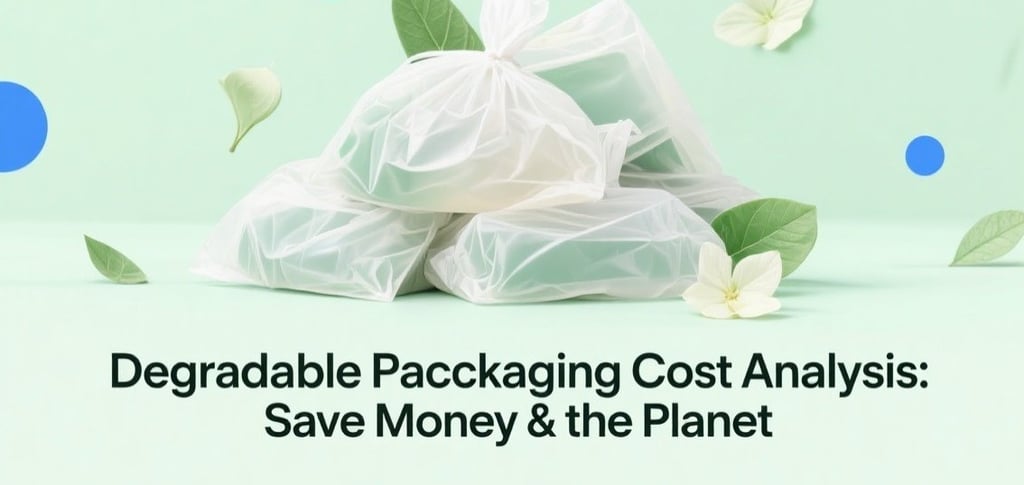Degradable Packaging Cost Analysis: Save Money & the Planet | Prowpackaging
Ryan Miller
6/20/20252 min read


What Drives Degradable Packaging Costs?
Raw Material Expenses (50-60% of Total Cost)
PLA (Polylactic Acid): Derived from corn starch or sugarcane, PLA costs 1.5–2× traditional plastics (3.5K–5.2K/ton vs. $1.8K/ton).
PHA (Polyhydroxyalkanoates): Priced at $11.8K/ton, PHA’s high cost stems from complex microbial fermentation processes.
Cost-Saver Tip: Blend starch or cellulose with synthetic polymers (e.g., PLA-PCL composites) to reduce material costs by 15–25%.
Production & Processing (20–30% of Total Cost)
Energy-intensive processes like extrusion and injection molding inflate expenses. Equipment investments (e.g., bio-resin-compatible extruders) add 10K–100K upfront.
Cost-Saver Tip: Scale production to lower per-unit costs—e.g., mass-producing PLA containers cuts costs from 0.50 to 0.30/unit.
Logistics & Compliance (10–15% of Total Cost)
Degradable materials often require temperature-controlled shipping and specialized certifications (e.g., ISO 14855). Transport adds 0.10–0.30/unit.
The Hidden ROI: Why Costs Pay Off
Policy Incentives: Governments worldwide subsidize degradable packaging. China’s 2025 circular economy plan offers tax breaks for certified bio-materials.
Consumer Loyalty: 80% of consumers pay up to 10% more for eco-packaging, boosting lifetime value.
Waste Reduction Savings: Compostable packaging slashes landfill fees by 30–50% vs. traditional plastics.
Cost Comparison: Degradable vs. Traditional Packaging
Cost FactorDegradable PackagingTraditional PlasticMaterial Cost/ton3.5K–11.8K1.8K–2.5KProduction Cost/unit$0.80$0.60Disposal Cost/ton$50 (compost)$150 (landfill)Total (10K units)$12K$8.5KNote: Long-term savings from reduced fines, subsidies, and brand equity offset initial gaps.
4 Ways to Slash Costs by 30%
Optimize Blends: Use 30% starch-PLA composites for food containers—cuts costs while meeting ASTM D6400 standards.
Localize Sourcing: Partner with regional bio-material farms (e.g., corn/PLA suppliers) to reduce transport fees.
Pre-Consumer Recycling: Integrate 20–40% recycled PLA from factory scraps—reduces virgin material needs.
Automate Production: AI-driven molding machines trim labor costs by 15%.
Future Outlook: Costs Will Plummet
By 2030, degradable packaging costs will drop 40% due to:
Tech Advances: Enzymatic recycling and algae-based PHA entering mass production.
Regulatory Push: Single-use plastic bans in 130+ countries will drive economies of scale.
Conclusion: Sustainability Is an Investment—Not an Expense
Degradable packaging isn’t just eco-friendly—it’s a strategic asset. Start small: Pilot compostable pouches for high-margin products (e.g., organic snacks). Track savings from waste reduction and customer retention. The planet—and your balance sheet—will thank you.
📧 info@prowpackaging.com
📞 +86-158-9993-2925
© prowpackaging.com 2025.
PROWPACKAGING ™
Quick Links
Our Products
Specializing in environmentally friendly biodegradable packaging solutions. Our PLA+PBAT fully degradable packaging bags are certified and customizable.
Contact Info
⌚ Mon-Fri: 9:00 AM - 6:00 PM
Building 1, 481 Dongkeng Avenue South, Dongkeng Town, Dongguan City, Guangdong Province, China
